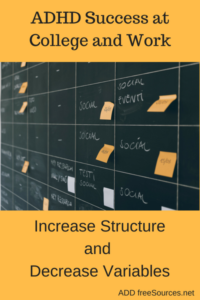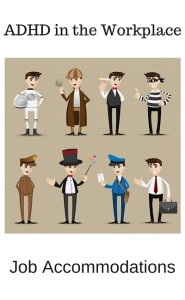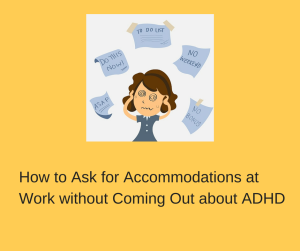ADHD is Not Just for Kids
Adults with ADHD often have fewer obvious symptoms than do those diagnosed as children. In fact, until 2011 the guidelines for diagnosing ADHD did not include adults. The thinking until recently was that kids would ‘outgrow’ ADHD after puberty. Research has shown what I and millions of others can attest to – at a minimum, 50-65% of us continue to have symptoms into adulthood. The symptoms may be to a lesser degree or change a bit, but they are ever-present.
Because this disorder is often misunderstood, many people who have it do not receive appropriate treatment and, as a result, may never reach their full potential. Part of the problem is that it can be difficult to diagnose, particularly in adults. There are an estimated 4 million adults with ADHD, and only 10% of adults with ADHD receive treatment.
There are three types of presentations of ADHD based on the degree key behaviors of ADHD in childhood – Inattention, hyperactivity, and impulsivity – symptoms present. Everyone will have some of these behaviors at some time, but for children and adults with ADHD, they occur frequently, are evident in more than one setting and must actually impair everyday functioning. Please see the ADHD Diagnostic Criteria: DSMV for more information on the diagnostic process.
Hyperactive/Impulsive Type: By adulthood, only 5% of kids who had this type of ADHD still show outward signs of hyperactivity.
The primary symptoms in adulthood are feelings of restlessness, acting/speaking without thinking, fidgeting, impulsive or compulsive behavior (eating, shopping, gambling, drinking, sex, etc.), impatience, problems regulating emotions, acting without thinking, etc.
Inattentive/Disorganized Type: 20% of adults with ADHD have the Inattentive type. Many women who were not diagnosed as kids recognize the symptoms when they leave the structure and help of home and high school for college, work and/or running a household.
The symptoms include procrastination, time management, losing things, not finishing projects or chores, wandering thoughts, clutter, tardiness, forgetfulness, thinking without acting – cognitive anxiety.
Combined Type: 75% of adults with ADHD have the Combined presentation. These people have symptoms of both Inattentive and Hyperactive ADHD. This can be very unpredictable.
As an adult with Combined ADHD, I have some days when the symptoms of hyperactivity or impulsivity are worse, and other days when the inattention/disorganization is worse. There are really crazy days when all the symptoms are flaring up, but these are rare and based solely on what is happening in my life at the time. Whatever the presentation, many report their symptoms to vary greatly – that there are days when the symptoms seem worse and other days when they feel ‘almost normal’.
Perhaps the most confusing thing about ADHD is that it occurs in some situations but not others.
ADHD symptoms increase when:
Variables increase (Distraction, choices)
Structure decreases (Accountability, deadlines)
Less stimulating tasks (Less dopamine produced)
Adulthood often brings about many of these changes. Those who choose the college route find that many of the safeguards that helped them succeed in high school as a kid or teen no longer exist. That includes a lack of accountability (missing class can be a huge issue and professors are unlikely to have the checks and balances for keeping up with class assignments) and many additional variables (classes are scheduled on different days at different times – new and varied social and peer activities take on more importance, competing with study time, etc.).
The most obvious change is the lack of parental oversight, support, and control. Most college freshmen struggle with time management and prioritizing. Those with ADHD had difficulty with these things under more ideal circumstances. Freshman year away from home with more freedom and independence often creates the perfect storm for young adults with ADHD. Many fall into the lure of the party life.
Adult ADHD Statistics Are Frightening
In a long-term study conducted by Russell Barkley and others, of those who continued to have ADHD symptoms, 38% had dropped out of high school—more than triple the dropout rate for Wisconsin students as a whole. Only 22% went to college, and only 5% graduated. In the control group, 77% of kids attended some type of college, including technical schools, and 35% completed a college degree, comparable to the national average.
Barkley found that 22% or more of young adults with ADHD struggle with addictive behavior, including alcohol and drug abuse and gambling. 60% or more of people with ADHD have problems with food, reporting eating disorders, being overweight or obesity. Researchers at Mass General Hospital found 32% of those studied with ADHD developed an addiction, and are high risk for nicotine addiction.
Is There Any Good News for Adults with ADHD?
There is some good news. As one who struggled to stay in school due to undiagnosed ADHD (before it was mainstream in the early 60s), I can say that progress in the research has greatly improved our understanding and treatment of the disorder. It is much easier to recognize now, and even adults who were not diagnosed as children have an opportunity to get proper treatment. People who get diagnosed and treated have much better outcomes.
Professional Services
if you exhibit many of the symptoms of ADHD in adulthood, take it seriously. Once you are properly diagnosed, a therapist or coach can work with you to learn the skills and techniques mentioned above. A psychiatrist will need to evaluate you to determine if medication would be helpful. If so, s/he will need to see you monthly for refills as most medications for ADHD are controlled substances and cannot be refilled. The right therapist or coach, when knowledgeable about ADHD and how it impacts functioning and emotions can also be helpful. Certain types of therapy such as Dialectical Behavior (DBT) or Cognitive Behavior Therapy (CBT) are proving to be effective. Find conventional Professional Service providers through our Find Treatment and Support section. Some studies and anecdotal reports support the use of less frequently used complementary or alternative treatments such as mindful meditation, supplements, dietary changes, neurofeedback, and others. For much more about treating ADHD, see our Pinterest pages Medication- A valid option, Holistic Treatment and Alternative and Complementary Treatments
There are many things you can do daily to manage the symptoms. At some point, our young adults with ADHD will either go to college or enter the workforce. Those who take the college route will find they have less academic assistance, little family support, and minimal structure. If they succeed, it will be because they reach out for (and accept) help. Others who enter the workforce realize that getting support and assistance to succeed becomes even more difficult. Dealing with ADHD is difficult, but it can be managed. Don’t judge yourself harshly for something that isn’t your fault!
There is no cure for ADHD but the following tips help a great deal.
- Diet and exercise: Eating a diet that is high in protein and low in carbohydrates is helpful. Protein is a precursor of the neurotransmitter dopamine. Exercise also helps regulate dopamine and norepinephrine. These two lifestyle choices can be easily adapted to help with symptom management.
- ADHD Coaching or Therapy: College students may need some assistance from an ADHD coach or therapist to develop healthy coping skills, learn how to plan, prioritize and manage daily tasks, etc. The Edge Foundation specializes in helping college students. Check out our section on Coaching to find them, other ADHD coaches, and coaching groups.
- Self-management: The term discipline takes on a whole new meaning when you are learning to live independently, succeed in college and manage a social life. Learn to make choices based on what is best for you in the big picture – some parties may have to be skipped to complete school work. Many people use timers, planners, white noise, specially arranged study areas and more to help with this. A coach or therapist who specializes in ADHD can help you figure out what works for you.
- Sleep and Downtime: Free time is a rare commodity in college, but a necessary one. Get plenty of rest – take naps if you need to. 70% of adults with ADHD report sleep problems so find the schedule that works for you and get your 8 hours. Don’t underestimate the negative effects of occasional or chronic sleep deprivation.
- Accommodations: If you need accommodations in the classroom, talk to someone at your college about your needs. These requests are usually handled by the Office of Disabilities – ADHD is a disability for many who have severe symptoms. You will need official documentation of the disorder from a medical provider. Once you provide that, your rights are protected under the Americans with Disabilities Act. Check out Employees with ADHD for specific situations where the ADA applies and for help with accommodations from JAN (Job Accommodation Network.)
Problems in the workplace often include poorly developed Executive Functions. Anything that requires more (or different) planning, prioritizing, time management and concentration on routine tasks could create a change in ADHD symptoms. Other external factors like stress, work relationships, being micro-managed and distractions in your work environment could also create problems on the job. As you can imagine, these are all skills that are necessary to be successful in most jobs
Tips for finding success with ADHD include many specific strategies based on addressing outlined in another article we have from the same author.
Adult ADHD: Recommendations for Management and Treatment
Many executive functions can be externalized:
- Notes and checklists to help with working memory deficits
- Timers and alarms help with hyperfocus and time management
- Automatic Bill Paying can help with money management
- A special location for keys, purse, etc. (called the launching pad)
- Rituals in the morning/evening (Includes using a launching pad and landing zone.)
The hardest thing for Inattentive types are motivation, initiation and follow through.
- We need a certain level of stress to get moving
- Without the rush of dopamine, we often need external motivation (deadlines – invite friends over to get the house clean) and frequent rewards, reinforcement or punishment (can’t do what I want until I do what I need)
- Hire people to do what you can’t or simply won’t, if possible.
- Work with a coach
Learn basic communication skills to improve relationships at home and work:
- Active listening/paraphrasing helps with remembering and clarifying details as well as meeting expectations and deadlines
- I – messages help with emotional regulation as they learn to identify how they are feeling and own it
- Request things in writing to help with organization and time management
- Role play – You may best learn/remember by doing and repetition
Develop rules to help with impulse control and other symptoms:
- Remember conversations – make notes of key points
- To prevent blurting out comments – write down 1-word reminders of things you want to say and continue to listen
- Complete tasks – note thoughts you want to follow up on or to return to after you complete your current task
- Containment of excessive movement and talking – arms crossed, hand over mouth
- For focus – Doodle, rock, sway, knit or fidget.
Many difficulties in the workplace can be managed. Diminish your individual struggles by developing the aforementioned strategies, techniques, and skills. Choosing the right job for yourself based on your interests and values, your skills and strengths, and asking for help are also keys to being successful at work.
Prevention is the key to managing ADHD, to be effective, productive and successful at work:
- Do not over-schedule – leave extra time between all tasks and leave 15 minutes early for work, etc.
- Work with your symptoms – find a job that fits your skills and create a schedule that fits your sleep patterns.
- Stop trying to be perfect – recognize limits and own your mistakes.
- Make it okay to be different – celebrate your differences and help others understand your needs and strengths.
Additional resources from the editor:
Do you Struggle to Explain your ADHD at Work? by Marla Cummins discusses disclosure and provides more ideas for receiving the help you need to succeed. If you choose not to tell, see How to Ask for Accommodations at Work Without Coming Out About ADHD by ADHD coach Linda Walker.
Resources:
“ADHD Linked to Substance Abuse Risk | Harvard Gazette.” Harvard Gazette. Harvard.edu. Web. June 9, 2018.
“Adult ADHD Outcomes.” Adult ADHD Help. Web. June 9, 2018.
Pierce, LuAnn. “Adult ADHD and Self-Advocacy: 10 Tips for Facing Giants.” Adult ADHD Help. Web. June 9, 2018.
“Recommended Accommodations for College Students with ADHD.” College Accommodations. Attention Deficit Disorder Association. Web. June 9, 2018.
(Another note from the editor: Charles Parker, author of ADHD Medication Rules, proposes that ADHD is NOT 24/7 in his 5-minute video Reality- ADHD in Context. Lim S. Pittman (https://www.facebook.com/liam.s.pittman) “takes issue with the caption stating that ADHD isn’t 24/7 on a Facebook post. “It is always there, he states, “That does not mean the symptoms are always being exhibited. And the picture explains why. But ADHD is an acronym for a diagnosis that explains how the affected individual’s brain operates. The brain of an ADHD person always operates the same in response to varying stimuli. Just because the response isn’t a negative symptom doesn’t mean it’s not fully operating within the contexts of how an ADHD brain works.”)
About the Author: LuAnn Pierce, LCSW has 30+ years in the field and has been a guest author for a number of mental health-based websites. LuAnn offers solution-focused counseling to people in Colorado and Wyoming from the comfort of your own home via teleconference or telephone. She also provides training and curriculum development to a variety of organizations. Contact Information: linkedin.com/ – Luanne Pierce, LCSW or luannpierce@gmail.com
These originals articles are used with permission from Theravive.com. “Our purpose is to help people everywhere find great counselors and psychologists. Everyone can have a new start in life. Unfortunately, the articles are no longer posted at their previous URL address (HTTP Error 503. The service is unavailable.)
- Adult ADHD: On the College Campus and in the Workplace and
- Adult ADHD: Recommendations for Management and Treatment
Photo by Daniele Riggi on Unsplash Modified on Canva.com
Applicable Pinterest boards include:















